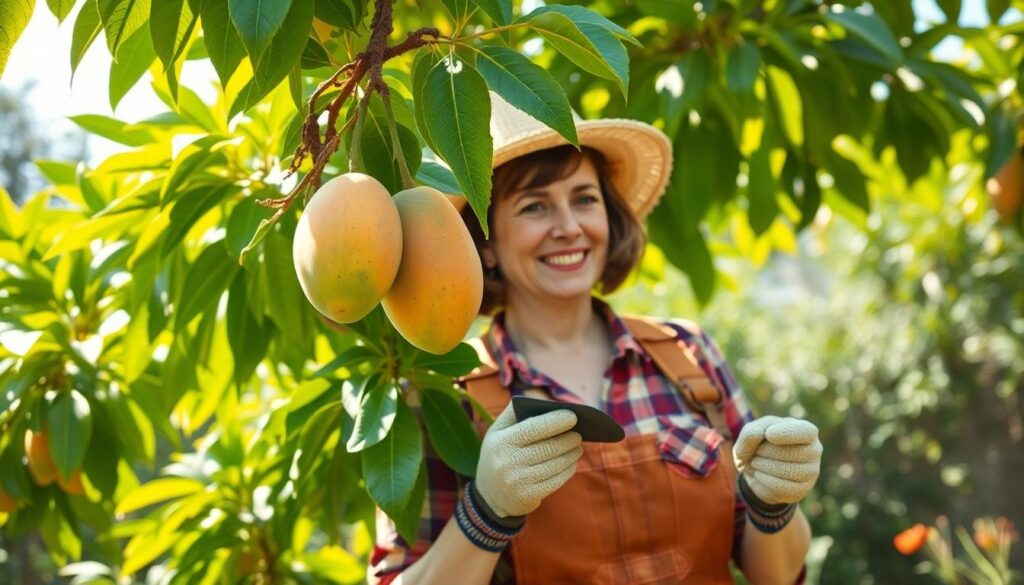Are you dreaming of harvesting sweet, juicy mangoes from your garden sooner? We’ve discovered proven techniques to accelerate mango tree growth and boost fruit production significantly. From selecting the right varieties to implementing strategic care practices, growing mangoes faster is entirely within your reach.
We’ll share our expert knowledge on optimizing soil conditions, proper watering techniques, and essential nutrients that stimulate rapid growth. Our methods have helped countless gardeners reduce the waiting time from planting to first harvest. Whether you’re a beginner or experienced grower, these accelerated growth strategies will transform your mango cultivation experience.
Understanding Mango Tree Growth Cycles
Mango trees follow distinct growth patterns that every grower should understand to maximize productivity and accelerate fruit development. Knowing these cycles helps you intervene at the right moments to boost growth and fruit production.
Typical Growth Timeline for Mango Trees
Mango trees typically take 5-8 years to produce their first substantial harvest when grown from seed. Grafted varieties significantly accelerate this timeline, often bearing fruit within 3-4 years after planting. The first year focuses primarily on root establishment and vegetative growth, with the tree developing its foundational structure. During years 2-3, properly maintained grafted trees begin forming flower panicles, though many growers remove these early blooms to redirect energy toward stronger vegetative growth. Years 4-6 represent the transition to productive maturity, with harvest quantities steadily increasing. Most mango varieties reach peak production between years 10-20, potentially yielding 200-300 fruits per season under optimal conditions. Commercial orchards often replace trees after 25-30 years, though well-maintained trees can remain productive for 80-100 years in favorable environments.
Factors That Naturally Affect Mango Growth
Temperature fluctuations dramatically influence mango development, with growth slowing significantly below 55°F (13°C). Day-night temperature differentials of 18-22°F trigger flowering in most varieties, explaining why proper seasonal changes are crucial. Sunlight exposure directly correlates with photosynthesis rates and carbohydrate production, with trees requiring 6-8 hours of direct sunlight daily for optimal growth. Rainfall patterns and humidity levels affect both vegetative growth and flowering, with moderate humidity (50-60%) supporting healthy development while excessive moisture increases disease pressure. Soil type impacts root expansion and nutrient availability, with well-draining sandy loams providing ideal conditions for extensive root systems. Wind patterns influence pollination success and can cause physical damage to flowers and developing fruits during severe weather events. The presence of appropriate pollinators, particularly various bee species, affects fruit set rates and overall yield potential.
Selecting the Right Mango Varieties for Accelerated Growth
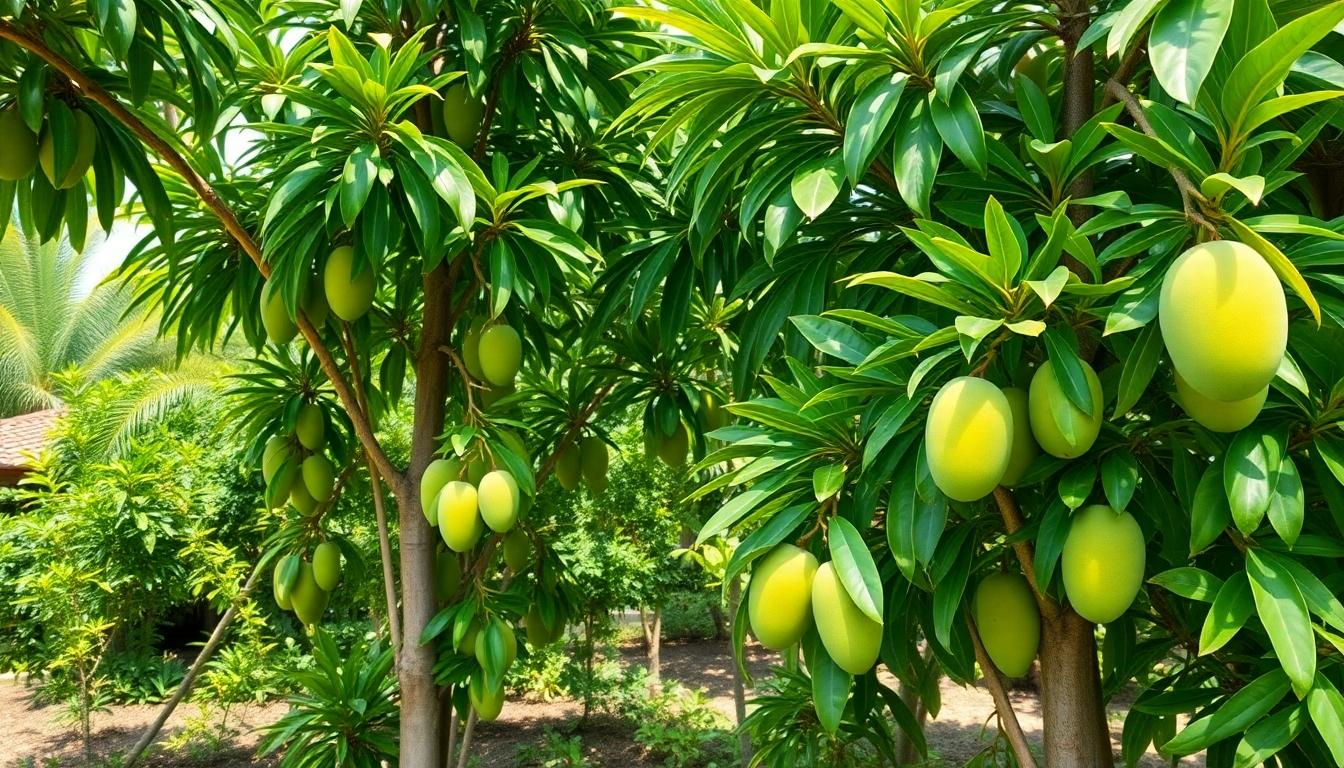
Choosing the right mango variety is perhaps the most critical factor for achieving faster growth and earlier harvests. The cultivar you select can dramatically impact how quickly your tree matures and produces fruit.
Fast-Growing Mango Cultivars
Glenn mangoes stand out as exceptional fast-growing options, reaching fruiting stage in just 3-4 years when grafted. This semi-dwarf, self-pollinating variety thrives in zones 9-11 and requires minimal space compared to larger varieties. Vigorous varieties such as VP, Jakarta, Edward, and Haden demonstrate impressive growth rates but demand more garden space to accommodate their larger mature size. Sunrise and Pineapple Pleasure mangoes also exhibit strong growth patterns, though gardeners should be prepared to carry out disease management strategies with these varieties. Grafted nursery trees consistently outperform seedlings in time-to-fruit metrics, producing harvests in 3-4 years versus the 5-8 years typically required for trees grown from seed.
Climate-Appropriate Selections
Mangoes naturally flourish in frost-free tropical and subtropical environments characterized by cool, dry winters and hot, humid summers. For gardeners in cooler regions (zones 4-11), container-grown semi-dwarf varieties like Glenn offer excellent adaptability, withstanding brief cold exposures down to 30°F. Grafted trees not only produce fruit faster but also maintain more predictable growth characteristics compared to seedlings. Polyembryonic varieties, particularly Turpentine types, may fruit sooner than other seedlings when grown from seed. Matching your selected variety to your exact climate conditions ensures optimal growth rates and prevents developmental setbacks that can delay fruiting.
Optimal Soil Preparation Techniques for Faster Mango Growth
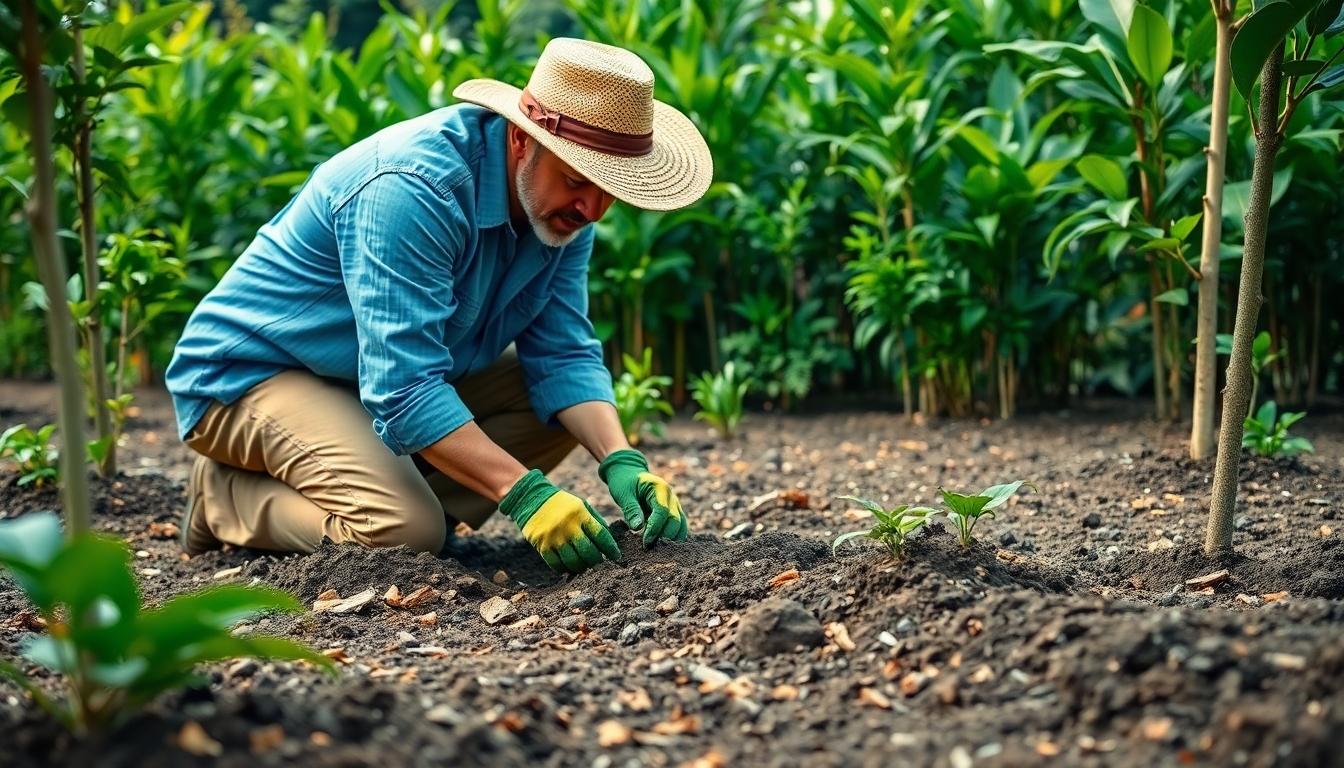
The foundation of successful mango cultivation begins with proper soil preparation. Creating the ideal growing environment will significantly accelerate your mango tree’s development and reduce time to fruiting.
Soil Composition and Amendment Methods
Mango trees flourish in well-draining, loose soil with minimal organic content. For optimal results, we recommend creating a soil mix that includes wood chips, coarse sand, peat moss, and a small amount of compost to ensure proper drainage while maintaining adequate moisture retention. Your soil should have sufficient depth—ideally 3 feet minimum, though depths of 19+ feet allow for robust root system development. Adding coarse sand (30-40%) improves drainage, while incorporating 10-15% organic matter such as composted mulch helps balance nutrient availability without creating waterlogged conditions. Poor soil conditions can be remedied with slow-release balanced fertilizer applied sparingly, as excessive nitrogen will actually delay fruiting. Applying wood chip mulch around your trees helps regulate soil temperature and reduces evaporation, creating more stable growing conditions for young mango trees.
pH Balancing for Maximum Nutrient Uptake
Mangoes thrive in slightly acidic to neutral soil with a pH range of 5.5-7.5. Testing your soil annually allows you to make informed amendments based on exact conditions in your growing area. For acidic soils below the ideal range, dolomitic limestone effectively raises pH to more favorable levels. Conversely, elemental sulfur can be applied to lower alkalinity in soils with pH above 7.5. Maintaining proper pH ensures optimal nutrient availability for your mango trees, particularly critical micronutrients like iron and zinc that become locked and unavailable in overly alkaline conditions. Full sun exposure and wind protection during early growth stages complement your soil preparation efforts, creating an environment where mangoes can establish quickly and progress toward fruiting. Container-grown trees require special attention to soil composition, with commercial blends like Fafard 3B (containing peat moss, bark, and perlite) or custom mixes with coco coir providing excellent results when repotted every 2-3 years with fresh medium.
Strategic Planting Methods to Jump-Start Your Mango Trees
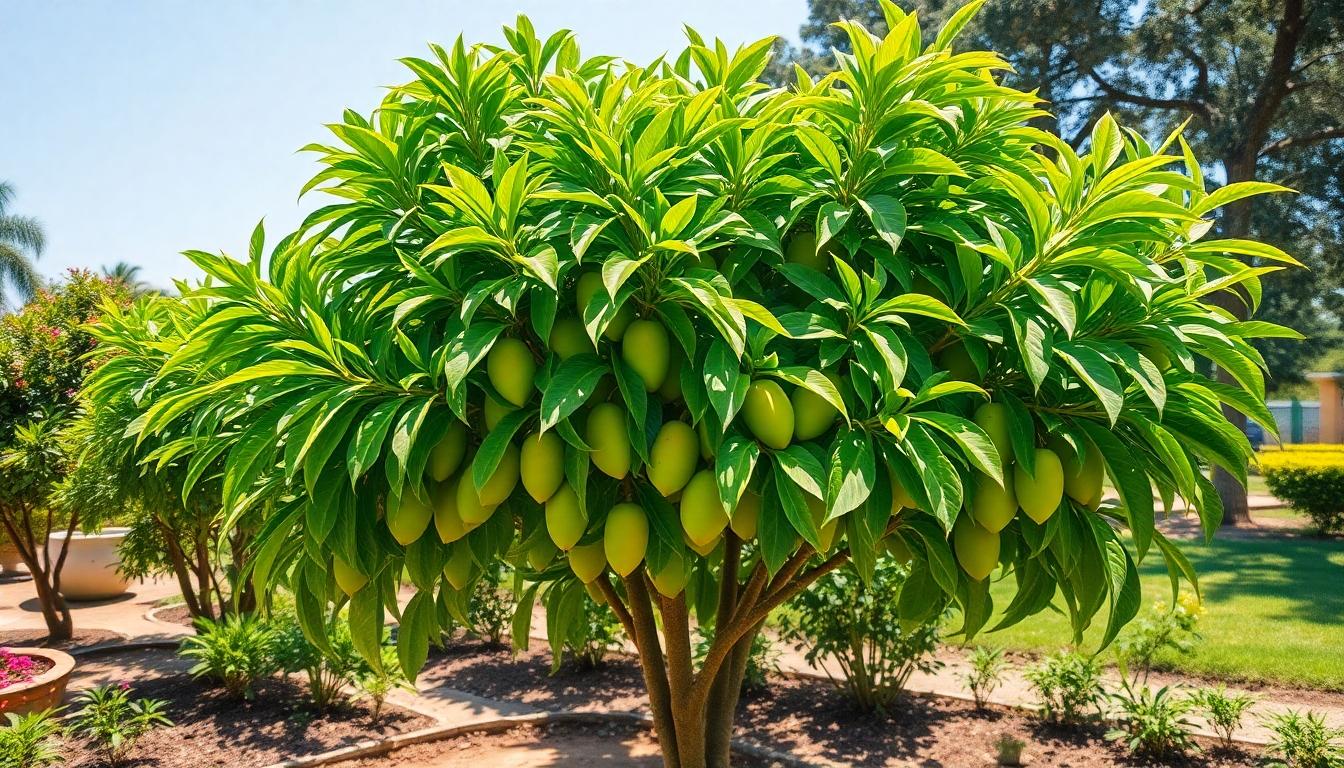
Implementing strategic planting techniques can significantly accelerate your mango tree’s growth and reduce the time to your first harvest. These proven methods focus on timing, technique, and positioning to give your trees the best possible start.
Air Layering
Air layering offers an effective alternative to seed propagation for faster mango tree establishment. This technique involves preparing a branch by making a clean cut and removing some bark to expose the cambium layer. Wrapping a polythene bag filled with cocopeat around the cut area creates the humid environment necessary for root development. Roots typically form within 6-8 weeks, and once they reach about 2 inches in length, the branch can be cut and transplanted into soil. This method produces trees that are genetic copies of the parent, ensuring consistent fruit quality.
Grafting
Grafting delivers remarkable results for accelerating mango production timeframes. The process involves joining a piece of stem (scion) from a desirable variety onto the root system of another plant (rootstock). This combination harnesses the best traits of both plants—often pairing vigorous rootstock with a productive fruiting variety. Grafted mangoes typically fruit 2-4 years earlier than seed-grown trees, making this technique invaluable for impatient growers. Professional nurseries often sell pre-grafted trees, though experienced gardeners can master this technique with practice.
Using Unconventional Substances
Several unconventional approaches have emerged among experienced growers seeking to boost mango growth. Some gardeners report success incorporating onions near the root zone, though this method lacks substantial scientific documentation. Also, a more unusual technique involves using Coca-Cola as a growth stimulant, with the theory that its sugars provide readily available energy to the plant. While these methods aren’t scientifically validated, some growers swear by their effectiveness in exact growing conditions.
Best Season and Time for Planting
Timing your mango planting correctly dramatically influences establishment and growth rate. Mangoes perform best when planted at the start of the rainy season, ensuring adequate moisture for initial root development. Planting before the onset of the dry season allows trees to establish themselves before facing moisture stress. Morning planting provides trees with a full day to recover from transplant shock before nightfall. Regional considerations matter significantly—tropical regions favor planting at the beginning of monsoon season, while subtropical areas benefit from early spring planting after the threat of frost has passed.
Proper Spacing and Orientation
Correct spacing serves as a critical factor in maximizing mango tree growth and productivity. Mango trees should be planted at least 20-30 feet apart to allow for proper canopy development and air circulation. Adequate spacing prevents competition for nutrients and sunlight while reducing disease pressure through improved airflow. Full sun exposure is essential for established trees, so selecting a location unobstructed by buildings or larger trees ensures optimal photosynthesis. Protection from strong winds helps prevent damage to branches and fruit drop, particularly in coastal or exposed locations. For container-grown trees, positioning on the south or southwest side of structures maximizes sun exposure in northern hemisphere locations.
Watering Strategies That Promote Rapid Mango Tree Development
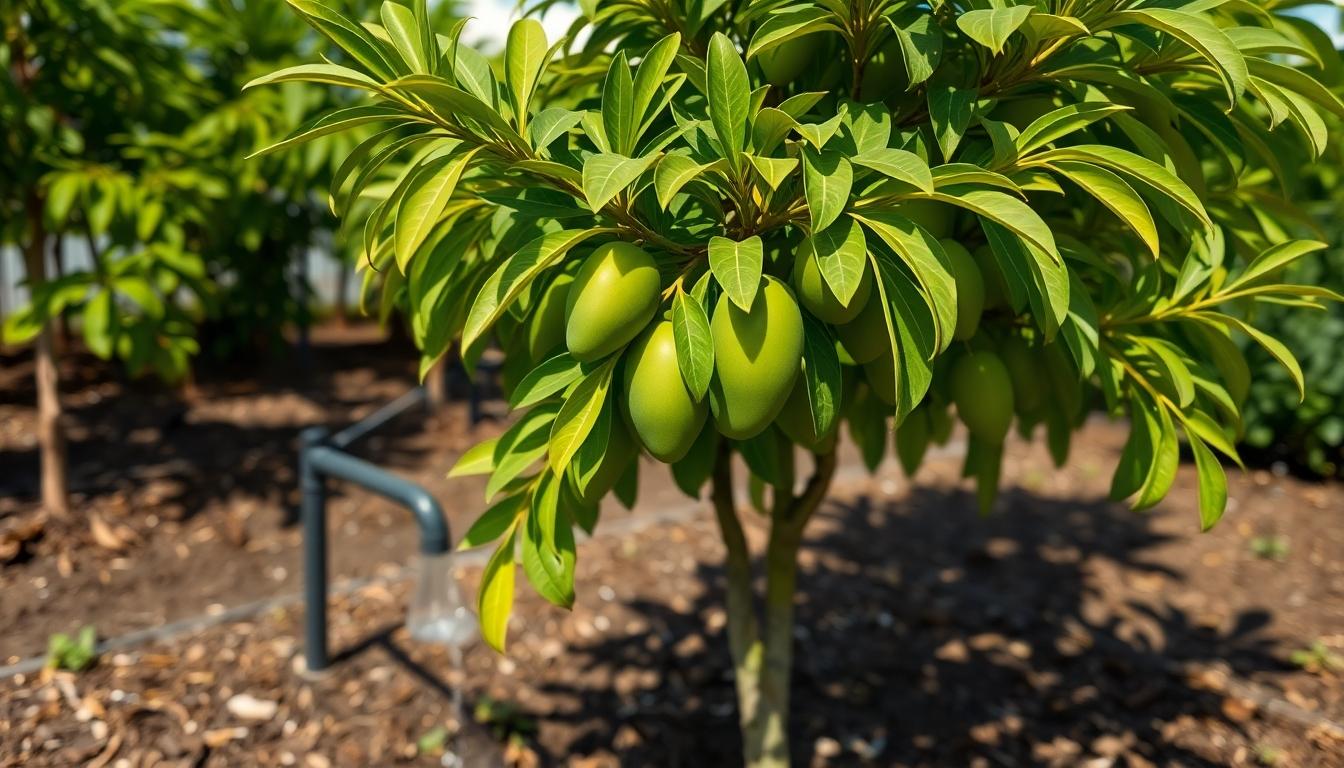
Proper irrigation is a cornerstone of accelerating mango tree growth. Strategic watering not only prevents stress but actively promotes vigorous development throughout all growth stages.
Irrigation Schedules for Different Growth Stages
Newly planted mango trees require daily hand watering for the first week after planting, even if you have an automated irrigation system. This consistent moisture ensures the rootball and surrounding soil remain adequately hydrated during the critical establishment phase. Young trees benefit from regular watering until they start developing new leaves and branches, as frequent irrigation can significantly enhance growth rates when soil drainage is good. Once your mango tree reaches approximately 4 to 5 feet in both width and height, you can reduce watering frequency unless you’re specifically aiming for extensive size increase. During fruit development, particularly in the first 6-8 weeks, maintaining consistent moisture is crucial to prevent stress-induced fruit drop and ensure continued growth.
Water Conservation Techniques That Don’t Sacrifice Growth
Smart irrigation practices can support rapid mango development while conserving water. Position sprinklers to reach beyond the trunk area, ensuring complete saturation of the entire root system for optimal nutrient uptake and growth. Implementing a rainwater collection system provides an excellent supplemental water source during dry periods, reducing dependence on municipal water while maintaining consistent moisture levels. Applying a 3-4 inch layer of organic mulch around the base of your tree (keeping it away from the trunk) dramatically reduces evaporation and maintains soil moisture levels between waterings. Well-draining soil is essential for mango trees, so incorporate organic matter if needed to improve drainage while retaining adequate moisture. Though mangoes demonstrate drought tolerance once established, young trees develop much faster with consistent moisture, making efficient irrigation particularly important during the first few years of growth.
Fertilization Secrets for Accelerated Mango Production
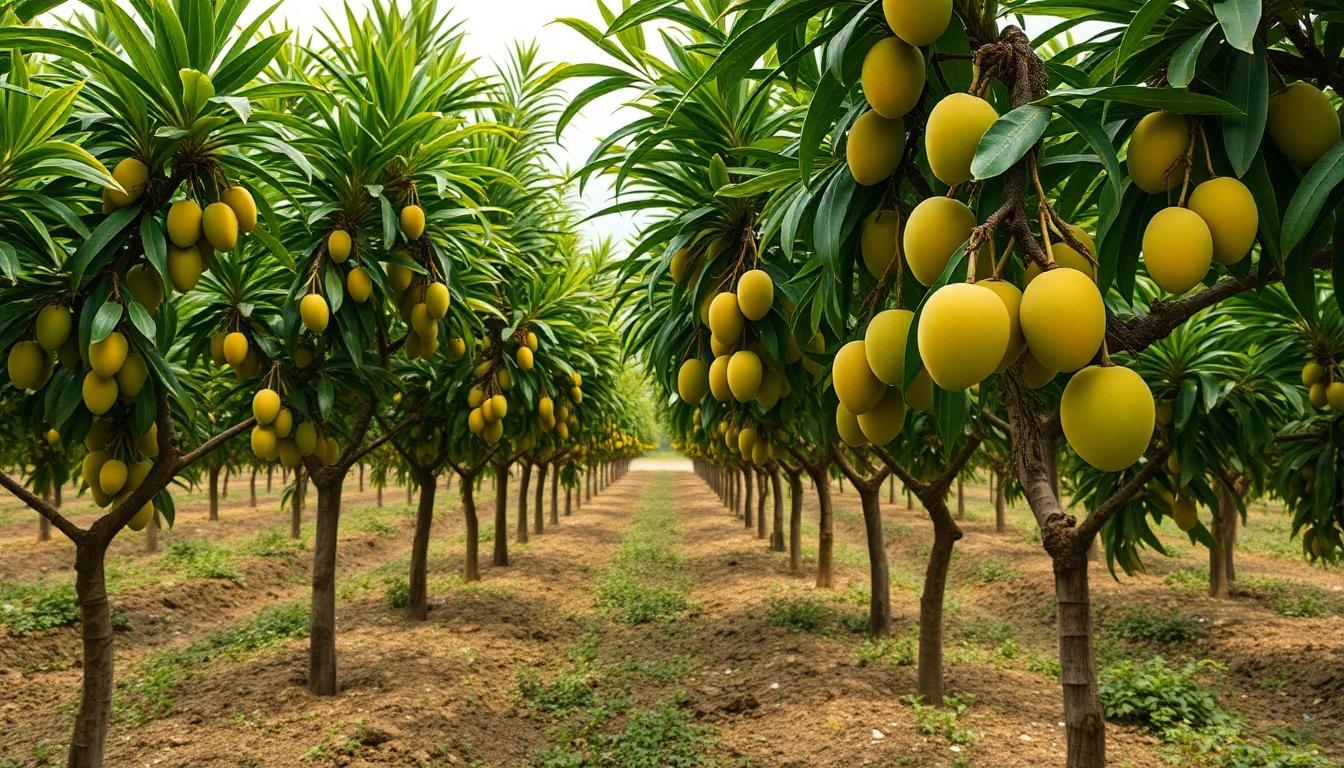
Proper fertilization is the cornerstone of accelerating mango growth and boosting fruit production. We’ve discovered that strategic nutrient application can dramatically reduce time to harvest while improving fruit quality.
Organic vs. Chemical Fertilizers
Organic fertilizers provide exceptional benefits for long-term mango tree health and production. Microbial organic fertilizers and decomposed livestock waste, particularly chicken manure, create an ideal foundation for robust root development and sustained growth cycles. Chemical fertilizers with balanced NPK formulations can deliver rapid results when quick growth is needed, though they should be applied with moderation to prevent root burn. Research shows that a combination approach often yields the best outcomes, with organic matter improving soil structure while targeted chemical applications address exact nutrient deficiencies.
Micronutrients play a surprisingly powerful role in mango productivity, with zinc supplementation alone demonstrating up to 45% productivity increases in controlled experiments. Other essential micronutrients include calcium and copper, which support critical physiological processes that accelerate fruit development and improve overall tree vigor. For comprehensive nutrition, we recommend incorporating these micronutrients alongside the standard NPK regimen to maximize growth potential.
Timing Your Fertilizer Applications for Maximum Effect
Monthly fertilization schedules produce the most consistent results for accelerating mango growth. This regular application pattern maintains optimal nutrient levels throughout critical growth periods, preventing the developmental delays that often occur with sporadic feeding approaches. Lighter, more frequent applications typically outperform heavy, infrequent ones by reducing nutrient leaching and maintaining steady availability.
Soil preparation significantly enhances fertilizer effectiveness and should be prioritized before application. Materials like rice husks, peanut shells, and coconut fiber improve aeration and drainage when incorporated into the soil around mango trees. These organic amendments create ideal conditions for root expansion and nutrient uptake, effectively multiplying the impact of your fertilization efforts. Seasonal adjustments to your fertilization schedule can further optimize growth, with slightly higher nitrogen applications during vegetative phases and increased phosphorus and potassium during flowering and fruiting stages.
Pruning Techniques to Stimulate Faster Growth and Fruiting
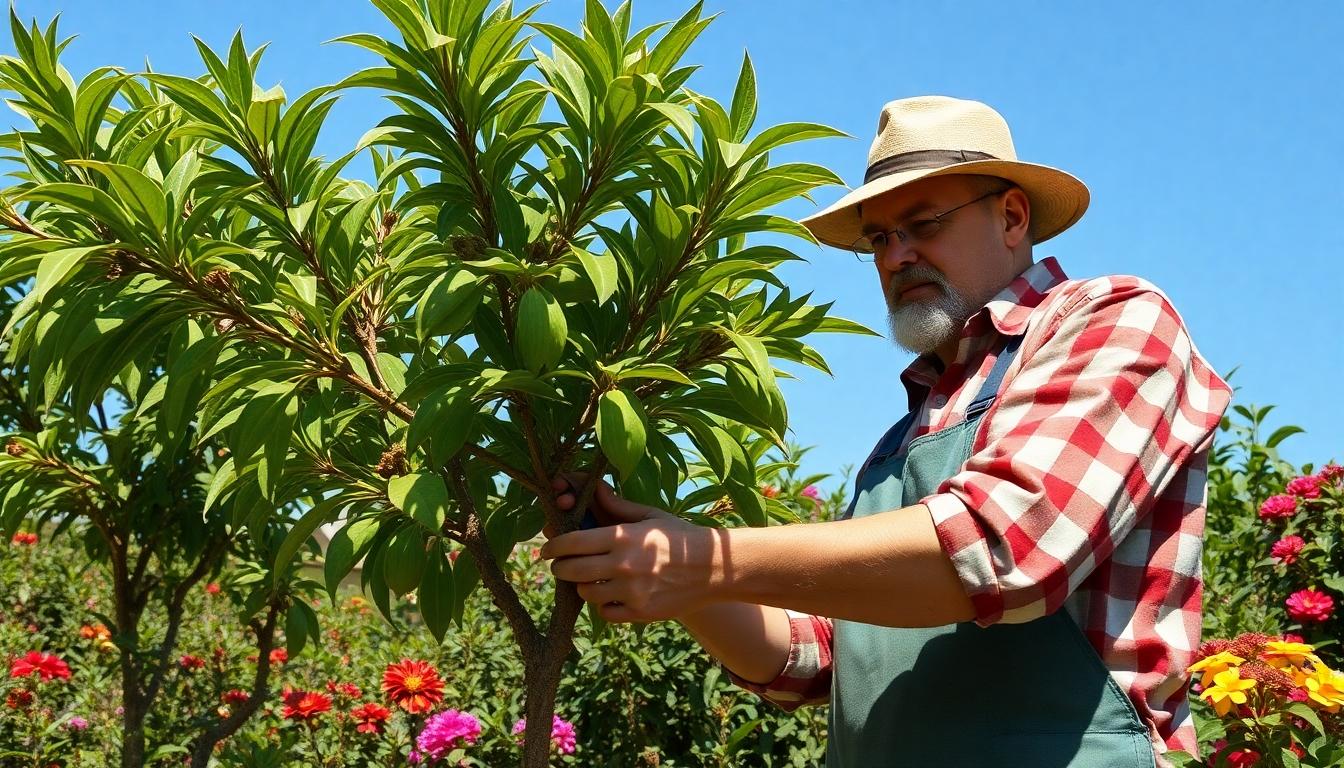
Proper pruning is a game-changer for accelerating mango tree development and improving fruit production. Strategic cutting stimulates branching, promotes earlier fruiting, and creates a robust framework for your tree’s future growth.
Formative Pruning for Young Trees
Young mango trees benefit tremendously from structured pruning to establish their productive framework. After planting, allow your tree to reach approximately 1 meter in height before cutting the main stem back to 0.7-0.8 meters to force lateral branch development. This initial heading cut is crucial for creating a well-branched tree that will fruit earlier and more abundantly. Trim horizontal branches to 0.6-0.8 meters beneath bud rings to stimulate more growth points, repeating this process every three months to trigger 4-7 lateral shoots per stem. Regular trimming dramatically reduces the juvenile period, shortening the time to first fruit from 3-4 years down to just 1-2 years. After 6-18 months of growth, we recommend pruning the main stem again to maintain a manageable height while simultaneously shortening side branches to promote dense, horizontal growth patterns that will support future fruit loads.
Maintenance Pruning for Established Trees
Established mango trees require systematic pruning to maintain productivity and accelerate growth cycles. Perform your most intensive pruning immediately after harvest when the tree can recover before the next flowering cycle. Remove lower branches up to 1.2 meters from the ground (a practice called “skirting”) to prevent fruit contact with soil and reduce disease transmission. Cut vertical shoots back to 0.2 meters near the trunk to maintain a compact shape and direct energy toward horizontal, fruit-bearing limbs that produce higher yields. Thin the center of your tree’s canopy and reduce side branches to approximately 0.5 meters from the trunk to improve airflow and light penetration, which significantly enhances flowering and fruit development. These maintenance techniques can boost productivity by an impressive 30-50% in well-managed systems, making proper pruning one of the most effective strategies for maximizing your mango harvest year after year.
Protecting Your Mango Trees from Growth-Inhibiting Pests and Diseases
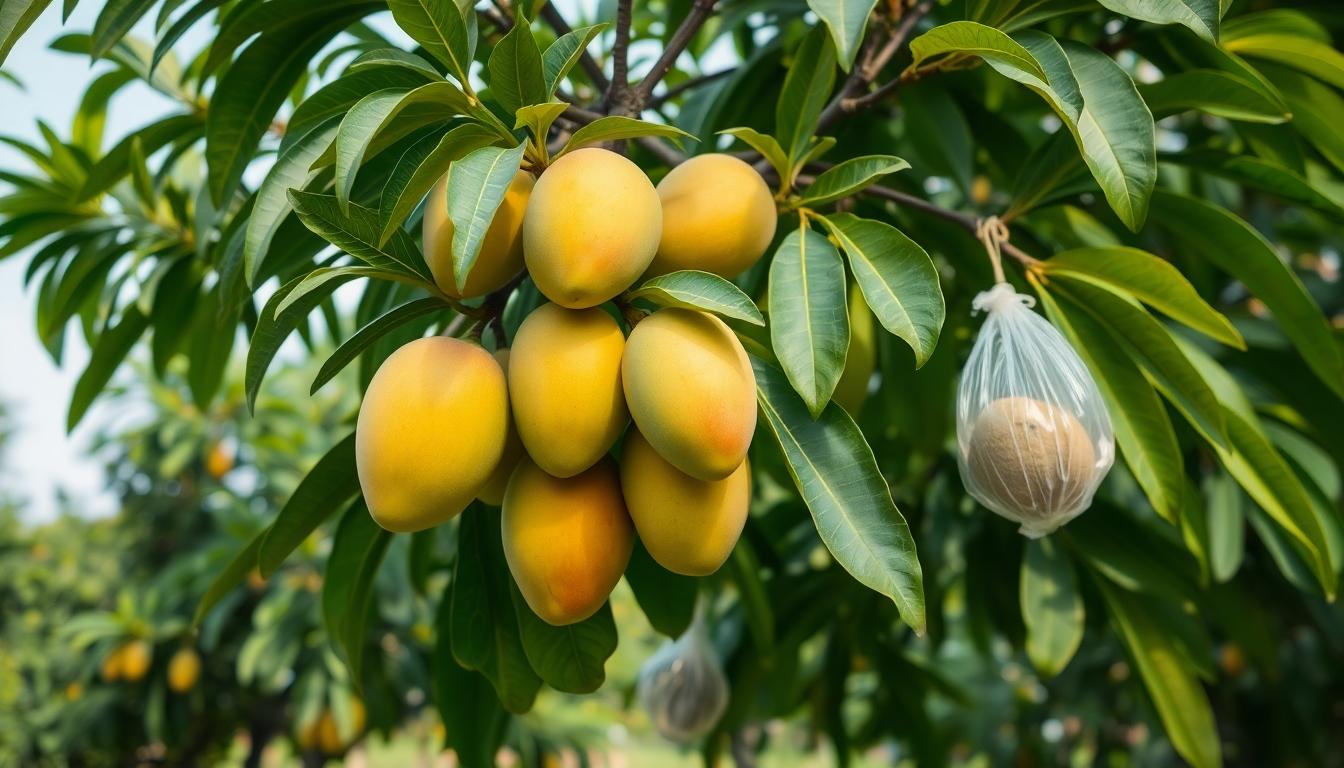
Mango trees face many threats that can significantly slow their growth and reduce fruit production. Addressing these challenges proactively is essential for maintaining healthy, fast-growing trees that reach their full productive potential.
Common Mango Pests and Prevention Strategies
Fruit flies pose one of the most serious threats to mango production, attacking developing fruits and causing premature drops. We recommend using pheromone traps strategically placed throughout your orchard to monitor and reduce adult fly populations before they can lay eggs. Bagging individual fruits with protective coverings creates a physical barrier that prevents female flies from depositing eggs on developing mangoes, significantly reducing infestation rates.
Mealybugs and scale insects attach to leaves and stems, sucking vital nutrients and slowing tree growth. Applying horticultural oil or insecticidal soap sprays directly onto these pests effectively suffocates them without harming beneficial insects. Natural predators like ladybugs can be introduced to your garden as they voraciously feed on these harmful pests, providing long-term biological control.
Borers represent another important threat, tunneling into the trunk and branches where they disrupt nutrient flow. Regular inspection of your trees allows early detection of entry holes and frass (insect waste). Remove infected bark carefully and apply appropriate insecticides directly to entry points to eliminate existing borers before they cause extensive damage.
Neem oil serves as an excellent organic pesticide option for multiple pest issues, disrupting feeding and reproduction cycles while being relatively safe for beneficial insects. Regular pruning improves airflow through the canopy, creating conditions less favorable for pest establishment and making it easier to spot infestations early.
Disease Management for Uninterrupted Growth
Anthracnose, a fungal disease that causes black spots on leaves and fruits, can severely impact tree growth and yield. Prune infected branches 4-6 inches below visible symptoms to remove the source of infection. Apply copper-based fungicides during humid periods when disease pressure is highest. Avoid overhead watering which creates the moist conditions that promote fungal spread.
Powdery mildew appears as a white powdery substance on leaves and can stunt new growth dramatically. Spray sulfur-based fungicides early in the season before symptoms appear for preventative control. Ensure adequate spacing between trees to improve air circulation, which naturally reduces humidity levels and disease pressure.
Bacterial black spot creates water-soaked lesions on leaves that eventually turn black and compromise photosynthesis. Remove and destroy fallen leaves promptly to eliminate sources of bacterial inoculum. Choose disease-resistant varieties when establishing new plantings to minimize future problems. Maintain proper nutrition, especially calcium levels, to strengthen cell walls against bacterial invasion.
Implementing regular sanitation practices forms the foundation of effective disease management. Clean pruning tools between cuts with a 10% bleach solution to prevent disease spread. Create a comprehensive seasonal spray schedule that addresses both fungal and bacterial pathogens during their peak infection periods. Monitor weather conditions closely, as temperature and humidity fluctuations often trigger disease outbreaks that require prompt intervention.
Advanced Growth-Boosting Methods for Experienced Growers
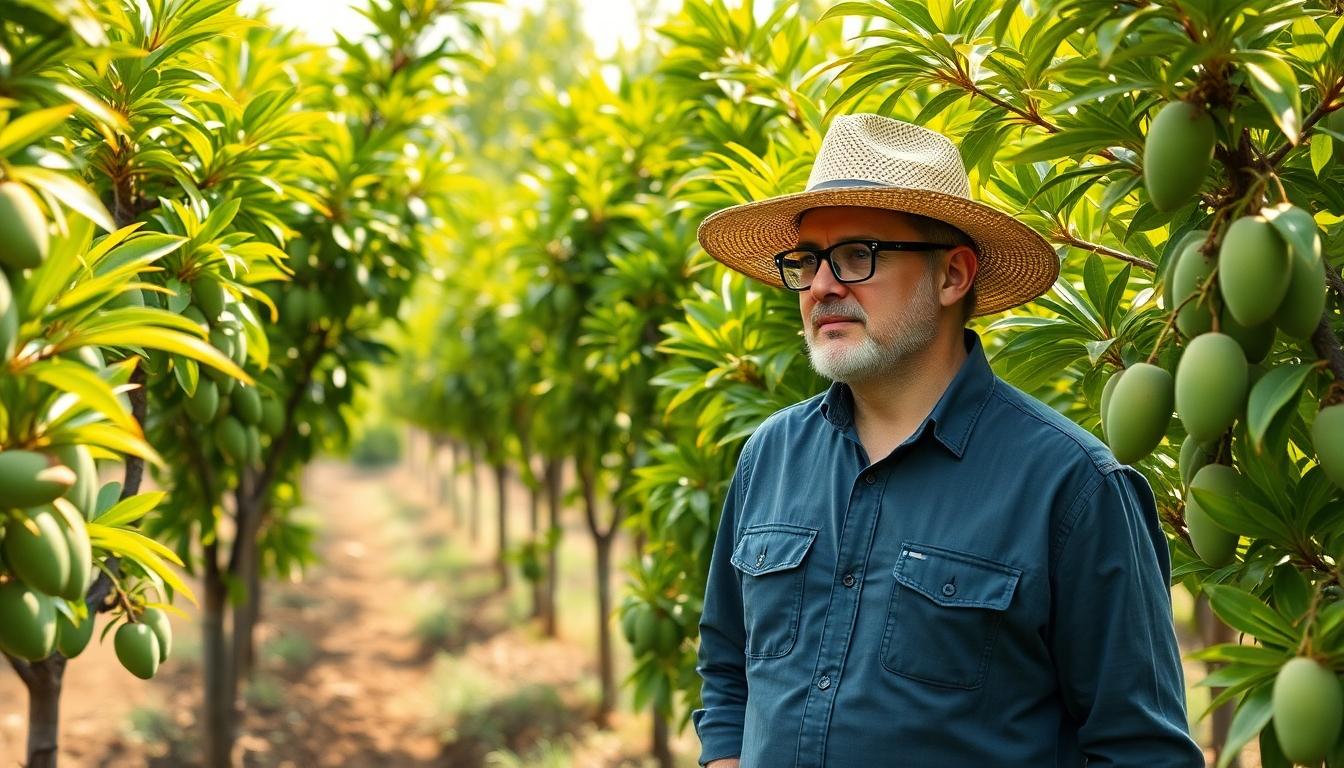
For growers with established experience in mango cultivation, we’ve compiled advanced techniques that can significantly accelerate growth and improve yields. These methods leverage cutting-edge agricultural practices designed specifically for commercial and serious home growers.
Ultra High-Density Planting (UHDP)
UHDP represents a revolutionary approach to mango cultivation that dramatically increases land efficiency. This technique allows growers to plant up to 900 trees per hectare, compared to traditional methods that typically accommodate only 100 trees per hectare. By positioning trees much closer together in a systematic pattern, UHDP creates opportunities for higher yields per land area while optimizing resource utilization. Implementing this advanced method requires precise planning but rewards growers with significantly increased production capacity.
Precision Agriculture and Soil Management
Modern soil monitoring technology provides unprecedented control over growing conditions. Soil moisture sensors deliver real-time data that helps prevent both overwatering and underwatering, ensuring optimal growing conditions throughout the season. Adding organic matter amendments, particularly high-quality compost, enhances tree vigor substantially while reducing overall fertilizer costs. These precision techniques allow experienced growers to fine-tune soil conditions based on exact data rather than general guidelines.
Advanced Irrigation Systems
Sophisticated irrigation setups ensure mango trees receive exactly the right amount of water at the right time. Drip systems deliver water directly to the root zone, minimizing waste and promoting consistent growth. Automated systems with soil moisture feedback loops can adjust watering schedules based on actual soil conditions, creating an optimal growing environment that accelerates development and improves fruit quality.
Grafting Techniques for Faster Production
Grafting represents one of the most effective methods for accelerating mango production timelines. Veneer grafting and epicotyl grafting stand out as preferred techniques for commercial propagation, enabling growers to obtain fruit-bearing trees in a fraction of the time required for seed-grown specimens. These methods involve joining vegetative parts of different trees to create plants that maintain the desirable characteristics of parent varieties while producing fruit much sooner. Commercial operations routinely employ these grafting approaches to ensure consistent quality and faster time-to-market for their mango crops.
Growth Hormone Applications and Their Benefits
While synthetic growth hormones aren’t generally recommended for mango cultivation due to environmental concerns and standardization issues, natural growth promoters can play an important role in accelerating development. Compost applications introduce beneficial microorganisms that naturally stimulate growth hormones within the plant system. These organic approaches enhance root development and overall tree vigor without the potential downsides of synthetic alternatives. Sustainable growers increasingly prefer these natural methods, which promote healthier trees with improved resistance to environmental stressors while maintaining eco-friendly growing practices.
Harvesting Strategies That Encourage Continued Rapid Growth
Growing mangoes faster isn’t just about getting to your first harvest quickly—it’s about establishing trees that will continue to produce abundantly for years. With the right variety selection smart watering techniques proper fertilization and strategic pruning we’ve shared how to transform your mango growing journey.
Remember that patience paired with these science-backed methods will yield the best results. Whether you’re implementing basic care practices or advanced techniques like UHDP and specialized grafting your efforts will pay off with earlier harvests and healthier trees.
By applying these accelerated growth strategies you’ll not only enjoy delicious homegrown mangoes sooner but also develop stronger more resilient trees that can withstand challenges and produce for decades to come.
Frequently Asked Questions
How long does it take for a mango tree to bear fruit?
Mango trees grown from seed typically take 5-8 years to produce substantial harvests, while grafted varieties can fruit within 3-4 years. Trees establish roots in the first year, develop structurally in years 2-3, and transition to productivity in years 4-6. Peak production occurs between years 10-20, depending on variety and growing conditions.
Which mango varieties grow the fastest?
Fast-growing mango varieties include Glenn, VP, Jakarta, Edward, and Haden. These cultivars not only establish themselves quickly but also begin fruit production earlier than standard varieties. These varieties have been specifically selected for their reduced time to maturity and are ideal for growers seeking quicker returns on their investment.
What type of soil is best for growing mango trees?
Mangoes thrive in well-draining, loamy soil with a pH between 5.5 and 7.5. The soil should be at least 3 feet deep to accommodate their extensive root systems. Annual soil testing is recommended to monitor nutrient levels. Adding organic matter like compost improves soil structure, drainage, and nutrient retention.
How often should I water my mango tree?
Young mango trees (1-2 years) need water 2-3 times weekly. Established trees require deep watering every 7-10 days during dry periods, with reduced frequency during the rainy season. Water at the tree’s drip line rather than near the trunk, and adjust based on rainfall, temperature, and soil moisture levels.
What fertilizers work best for mango trees?
A balanced NPK fertilizer (such as 10-10-10) works well for young trees, while mature trees benefit from formulations higher in potassium (like 8-3-10). Organic options include compost, manure, and bone meal. Apply fertilizer monthly during the growing season, reducing to quarterly for mature trees. Avoid fertilizing 2-3 months before flowering.
How should I prune my mango tree to stimulate growth?
Prune young trees to establish a strong framework with 3-4 main branches. For established trees, remove crossing, damaged, or inward-growing branches after harvest. Thin interior branches to improve airflow and sunlight penetration. Avoid heavy pruning before flowering or during fruit development to prevent yield reduction.
How can I protect my mango tree from pests and diseases?
Regularly inspect trees for signs of infestation or disease. Common pests include mango hoppers, fruit flies, and scale insects—control with neem oil or appropriate insecticides. Prevent diseases like anthracnose and powdery mildew by maintaining good air circulation, proper spacing, and using copper-based fungicides when necessary. Remove and destroy affected plant material promptly.
What are advanced techniques to accelerate mango tree growth?
Ultra High-Density Planting maximizes land efficiency by planting trees closer together. Precision agriculture techniques optimize soil conditions through targeted amendments. Advanced grafting methods like veneer and epicotyl grafting can drastically reduce time to fruiting. Natural growth promoters such as seaweed extract, mycorrhizal fungi, and beneficial bacteria enhance vigor and resilience.
Can mango trees grow in containers?
Yes, dwarf varieties like ‘Julie’ and ‘Irwin’ grow well in containers at least 20 gallons in size with drainage holes. Use high-quality potting mix with added perlite for drainage. Container-grown trees need more frequent watering and fertilizing. Move containers to protect from extreme temperatures and provide at least 6 hours of direct sunlight daily.
How do I know when my mangoes are ready to harvest?
Mangoes are ready when the fruit’s shoulder (the part near the stem) develops a fullness and sometimes changes color. The fruit should yield slightly to gentle pressure. Mature fruits often develop a fruity aroma at the stem end. Harvest timing varies by variety—some ripen green while others develop red, yellow, or orange blush when mature.

